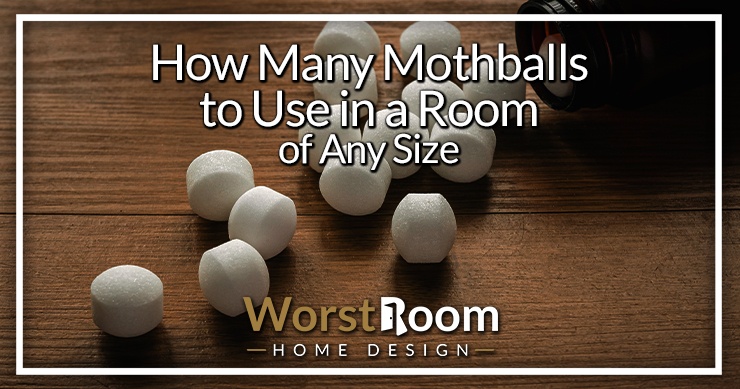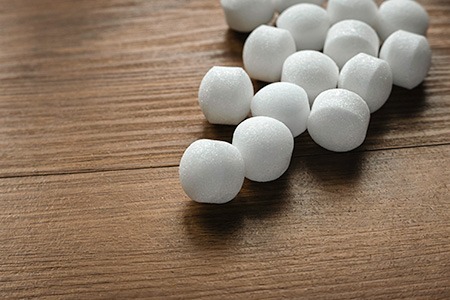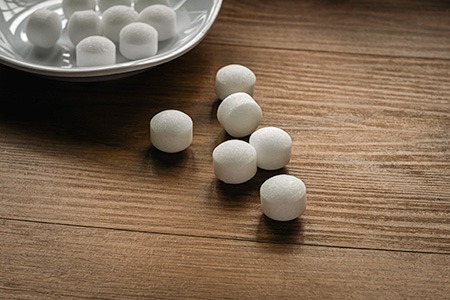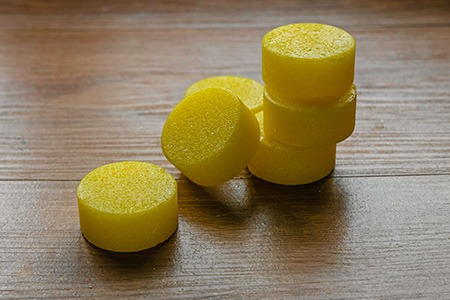How Many Mothballs to Use in a Room of Any Size
Author: Anne Cowart | Editor: Omar Alonso
Review & Research: Jen Worst & Chris Miller

Did you pull your favorite suit out of the closet for someone's wedding to find it full of holes? Moths are destructive pests, and they love dining on your clothing. If you have a moth infestation in your closet, it could ruin your wardrobe, linens, and fabrics. So, how do we know how many mothballs to use to prevent this problem?
Try spreading some mothballs around to prevent moths from getting into your closets and clothing. Mothballs are effective at keeping the moths away, and why they might not smell great, it's better than losing your clothing.
So, how many mothballs do you need to add to your closet? Are mothballs toxic or dangerous? This post unpacks everything you need to know about using mothballs in your home.
How Many Mothballs to Use

The size of the closet or area you want to protect determines the number of mothballs you need to use for the application. If the site is too large, the vapors can't build up to critical levels where they're toxic to moths and their larvae.
As a result, the moths will fall around without experiencing any harm. If you use too many mothballs in a small space, the vapors build-up, and they could reach levels that are toxic to human health. Let's look at how many mothballs to use in different applications.
How Many Mothballs to Use in a Garage?
In large rooms like garages, use up to 8 mothballs in the room to protect it from moth intrusions. Place the mothballs where they are away from pets like cats and dogs (remember, cats can climb), and keep them away from areas where possums and squirrels might encounter them.
Place the mothballs close to fabrics like clothing or upholstered furniture. Moths also like nesting in and chewing on paper. If you have boxes of books, add one or two mothballs per box to protect them.
How Many Mothballs to Use in a Room?
Use 2 to 4 moth balls in smaller types of rooms like bedrooms. If you have an unoccupied second home or a guest house you're not using, you can keep the moths out of the bedroom by placing three or four mothballs in a bowl in the middle of the room with the door closed.
How Many Mothballs to Use in a Closet?
Closets only require 1 or 2 mothballs since their small spaces. Don't place too many mothballs in your closet, or your clothes will smell of pesticides, especially if it's damp. If so, you can learn how to remove moisture from closets here.
If you overdo it and your clothing smells like mothballs, throw them into the washer to wash away the smell. In most cases, a single cycle with detergent and softener is enough to eliminate the pesticide smell on your clothing.
How Many Mothballs to Use in an Attic?
You should not use mothballs in your attic. You should also not use mothballs in a crawl space, trash can, your vehicles, or in your gardens.
You may think you can use these to keep squirrels, climbing skunks, and other pests out of these locations, but they pose a threat to your health. You can safely use them to keep birds off your porch, though, as long as your pets don't ingest them.
The naphthalene in the moth balls is a heavy toxic gas that seep into the home below the attic because the gas is heavier than air. It can accumulate and linger in the attic, causing far too much exposure when you enter the attic later.
How to Handle & Store Mothballs

Only use mothballs in places around the home that has good ventilation. Don't seal the mothballs in a Ziploc or clothing storage bag, as the vapors won't release into the area you want to protect.
If you overdo it with mothballs and breath in too many toxic vapors, you'll experience overexposure symptoms involving gastrointestinal issues. It's common for people to feel nauseous and develop abdominal cramps and diarrhea.
In severe cases of mothball overexposure, you'll develop acute symptoms involving possible renal failure, a life-threatening condition requiring immediate medical treatment. Inhaling just a small amount of vapor can cause severe irritation in the eyes, sinuses, and throat. You might also find you develop a headache.
Store mothballs in sealed containers, preferably outside the home, like the garage or shed. Store your mothballs properly, and they can last from six months to two years.
What Are Mothballs & How Do They Work?

Mothballs are small, compressed balls designed to keep away moths and flying pests out of your closet, boxes, and other storage spaces around the home and garage. They have a distinctive smell that most people recognize and are effective at keeping moths away.
Mothballs feature formulation and production with the chemical "naphthalene" or "paradichlorobenzene," derived from crude oil. In technical terms, a mothball is called a "fumigant insecticide." A fumigant is a substance that slowly "gases off," turning to a vapor as it interacts with the atmosphere around it.
It may be confusing that a solid can turn into a gas. After all, doesn't it have to be a liquid to evaporate? Fumigants can gas off, despite being solid. It's similar to the same process dry ice goes through when you leave it out. It evaporates by turning into CO2 gas instead of melting into a puddle like regular ice.
Moths are small creatures, and exposing themselves to the gases coming off mothballs kills them quickly. Conversely, a human being is hundreds of times a moths size, so these gases don't have the same effect on us at this scale.
Exposure to mothballs kills moths and their larvae, ensuring protection for your wardrobe. These flying pests can sense the presence of mothballs in a closet, and it's enough of a deterrent to keep them from nesting in it in the first place.
If the moth gets too close to a mothball, it dies within a few minutes. It's a fast-acting deterrent and highly effective for keeping moths away. Mothballs aren't only for keeping moths away. You can use them in several applications to keep all types of pests away from your property.
Some suggest that mothballs protect clothing and areas from pests like cockroaches, mites, spiders, water bugs, deer, squirrels, skunks, rats, and snakes. However, there's no proof that they keep these pests away from your food and snakes and spiders out of your tent. In the case of how many mothballs to use, more is not better. Use the proper, suggested amount.
Are Mothballs a Pesticide?

Mothballs repel these pests due to the naphthalene fumigant insecticide found in the formulation. The United States Environmental Protection Agency (EPA) approves mothballs for specific purposes. So, mothball manufacturing brands can sell mothballs commercially at grocery stores, big-box retailers, hardware stores, and online without restrictions as long as the marketing methods are responsible.
There are no caveats involved with purchasing mothballs. You can buy them over the counter in any quantity you want without needing a prescription or license.
Mothballs, crystals, and flakes are solid insecticides registered as pesticides due to formulation with high concentrations of the chemicals naphthalene or paradichlorobenzene (1,4-dichlorobenzene). Over 30 registered products with the EPA contain paradichlorobenzene, and over a dozen contain naphthalene.
Paradichlorobenzene is an ingredient in commercial deodorant blocks for toilets and trash cans. Manufacturing brands produce these products through a process known as "sublimation," where the finished product gases off.
The EPA requires all manufacturers of naphthalene or paradichlorobenzene products to use a warning label on the packaging displaying the legal requirements for the use of the product. Using mothballs in ways other than that indicated on the label can harm the environment, people, and pets.
Despite clearly labeling mothballs as a pesticide, government services receive thousands of complaints every year regarding the misuse of mothballs. While we've discussed the potential for mothballs to keep away other pests and problematic wildlife, this practice is technically illegal.
Are Mothballs Harmful or Poisonous?

Mothballs are a pesticide, and you should treat them as such. That means you need to limit your exposure to these products. Mothballs can potentially harm wildlife, people, and pets, that come into prolonged contact with the vapors emitted by these pesticides.
Adults are likely exposed to paradichlorobenzene or naphthalene by handling the mothballs or breathing in the vapors. Small children might put them in their mouths or eat them, risking poisoning. Children that eat mothballs require urgent medical care.
Naphthalene is produced when things burn, so naphthalene is found in the byproducts of combustion like car exhaust fumes, cigarette smoke, and forest fire smoke all contain this chemical.
When naphthalene enters the body, it breaks down into alpha-naphthol. Several studies show this chemical is responsible for causing hemolytic anemia, which is the breakdown of red blood cells.
As a result, the body cannot oxygenate blood properly, leading to lung, liver, and kidney damage and brain issues. Hemolytic anemia affects all organs and vital systems in the body. Ingesting paradichlorobenzene sees this pesticide distributed in the body's blood and fat stores and breast milk.
The World Health Organization (WHO) considers paradichlorobenzene potentially carcinogenic based on laboratory studies with mice. The EPA now also classifies the chemical as a "possible human carcinogenic". Let pest control get rid of mice instead of loading your house up with mothballs.
That's How Many Mothballs to Use in Each Room
Mothballs are effective at keeping moths away from your clothing and personal belongings. If you find holes in the clothes in the back of your closet or in old suit bags, it's moths causing the problem. Adding a few mothballs to the closet gives you everything you need to stop the destruction.
Don't overdo it with mothballs, or you risk overexposure to the toxic vapors, causing health issues. If your children accidentally eat a mothball or put it in their mouth, seek immediate medical assistance. If you're in a room with too many mothballs and develop headache, eye, sinus, or throat irritation, step outside and breathe until the symptoms subside.
Mothballs are a pesticide, and you need to treat them as such. Apply the correct number of mothballs to the space. How many mothballs to use? A box only needs one mothball, closets need one or two, a room needs three or four, and a garage needs six to ten mothballs.




